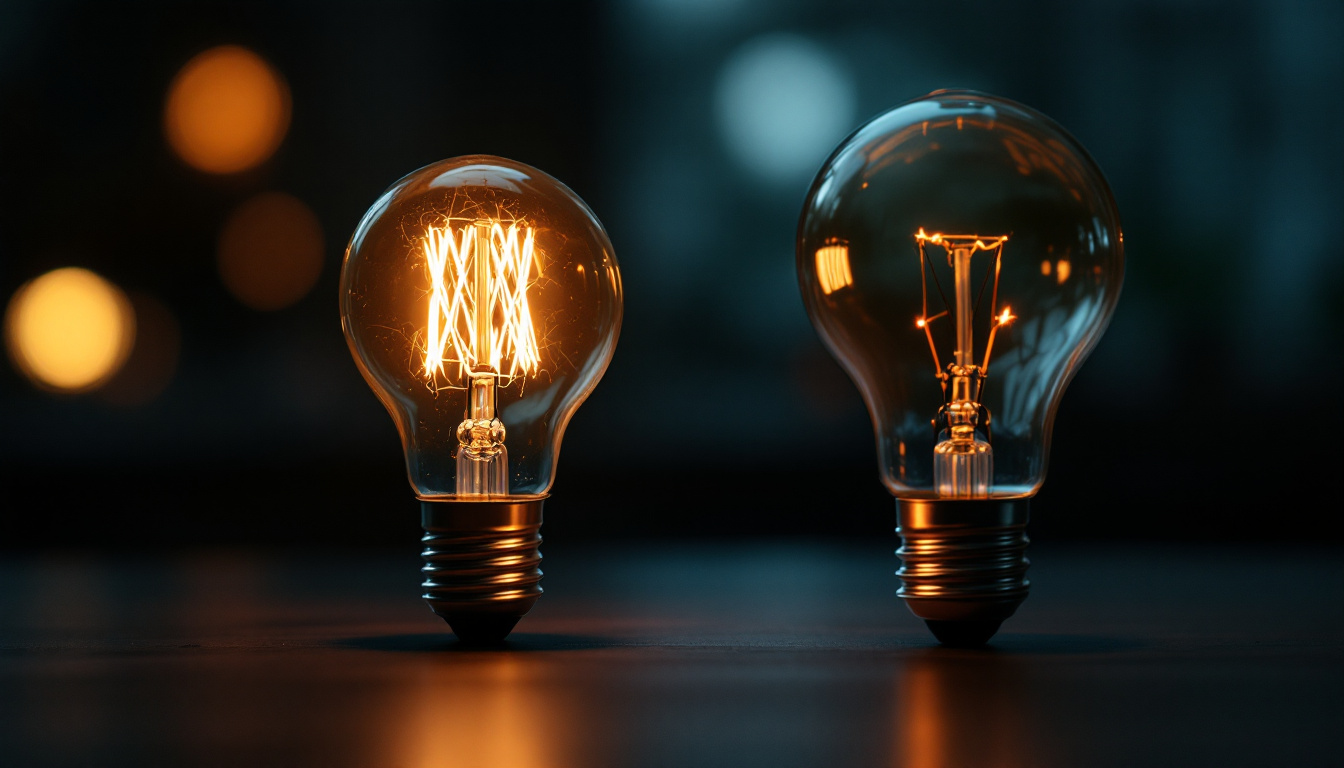
The lighting industry has undergone a remarkable transformation over the years, driven by technological advancements, environmental considerations, and consumer demands. Among the most significant innovations in this field is the evolution of the light bulb. From the early incandescent designs to modern LED technology, the journey of the light bulb reflects broader changes in society’s approach to energy consumption and sustainability. This article explores the various stages of this evolution, highlighting the key developments that have shaped the lighting industry.
The journey of electric lighting began with the quest for a more efficient and practical solution to illuminate homes and businesses. Early attempts at electric lighting were characterized by a variety of experimental designs, but it was the incandescent bulb that truly revolutionized the industry. The initial forays into electric illumination were fraught with challenges, as inventors experimented with different materials and methods to create a reliable light source. From arc lamps to early versions of the incandescent bulb, each innovation brought humanity one step closer to a brighter future.
Incandescent bulbs, which produce light by passing an electric current through a filament, became the standard for lighting in homes and commercial spaces. Their warm glow and relatively simple design made them a popular choice. However, the efficiency of incandescent bulbs was limited, as a significant amount of energy was wasted as heat. This inefficiency sparked a wave of innovation, leading researchers to explore alternative technologies that could provide brighter light with less energy consumption.
Despite their inefficiencies, incandescent bulbs dominated the market for decades. They were easy to manufacture and offered a familiar light quality that consumers appreciated. The invention of the tungsten filament in the early 1900s further enhanced the durability and lifespan of these bulbs, solidifying their place in households around the world. However, as energy costs rose and environmental concerns grew, the limitations of incandescent technology became increasingly apparent. This prompted a search for new lighting solutions that could meet the demands of an evolving society.
In response to the inefficiencies of incandescent bulbs, Fluorescent lighting emerged as a more energy-efficient alternative. Fluorescent bulbs use a different mechanism to produce light, utilizing gas and phosphor coatings to generate illumination. This technology offered a significant reduction in energy consumption, making it an attractive option for both residential and commercial applications. The introduction of compact fluorescent lamps (CFLs) in the late 20th century further popularized this technology, providing a more versatile option for consumers looking to save on energy costs.
Fluorescent lighting provided brighter and cooler light compared to incandescent bulbs, making it suitable for a variety of settings, from offices to retail spaces. The ability to produce larger quantities of light with less energy made fluorescent fixtures a staple in commercial environments, where efficiency and cost-effectiveness are paramount. However, the initial cost of fluorescent fixtures and concerns about the presence of mercury in their construction limited their widespread adoption. As manufacturers sought to address these issues, advancements in technology led to the development of more environmentally friendly alternatives, paving the way for the next generation of lighting solutions.
halogen bulbs represented another significant step in the evolution of lighting technology. These bulbs are a type of incandescent light but are designed to be more efficient and longer-lasting. Halogen bulbs use a halogen gas to increase the lifespan of the filament and improve energy efficiency. The introduction of halogen technology marked a pivotal moment in the lighting industry, as it bridged the gap between traditional incandescent bulbs and the more modern, energy-saving alternatives that would follow.
One of the key advantages of halogen bulbs is their ability to produce a bright, white light that closely resembles natural daylight. This quality made them popular for applications requiring high-quality lighting, such as in art galleries and retail displays. Additionally, halogen bulbs are dimmable, providing flexibility in lighting design. This versatility allows users to create varying atmospheres, from warm and cozy to bright and invigorating, making them a favorite choice for both residential and commercial spaces.
Moreover, halogen bulbs tend to have a higher color rendering index (CRI) compared to standard incandescent bulbs, which means they can reveal the true colors of objects more accurately. This characteristic is particularly beneficial in settings like photography studios and salons, where precise color representation is crucial. However, despite their benefits, halogen bulbs still fall short in terms of energy efficiency compared to newer technologies. As the demand for sustainable lighting solutions grew, the industry began to shift its focus toward more advanced options. Innovations such as LED and CFL bulbs started to gain traction, offering longer lifespans and significantly lower energy consumption, which prompted consumers and businesses alike to reconsider their lighting choices.
The introduction of light-emitting diode (LED) technology marked a turning point in the lighting industry. LEDs are semiconductors that emit light when an electric current passes through them, offering unparalleled energy efficiency and longevity. This innovation has led to a significant transformation in how lighting is designed and utilized.
One of the most compelling advantages of LED technology is its energy efficiency. LEDs consume a fraction of the energy required by incandescent and fluorescent bulbs, making them a cost-effective choice for consumers and businesses alike. Furthermore, LEDs have an impressive lifespan, often lasting tens of thousands of hours, which reduces the need for frequent replacements.
As energy efficiency became a priority for consumers and regulatory bodies, the adoption of LED technology surged. This shift not only contributed to lower energy bills but also had a positive impact on the environment by reducing overall energy consumption.
LEDs offer unparalleled versatility in design and application. They can be integrated into a wide range of fixtures, from traditional bulbs to modern strip lighting, allowing for creative and innovative lighting solutions. The compact size of LEDs also enables designers to explore new shapes and forms, leading to unique lighting designs that enhance architectural spaces.
Moreover, the ability to control LED lighting through smart technology has opened up new possibilities for automation and customization. Homeowners and businesses can now adjust brightness, color temperature, and even create dynamic lighting scenes, enhancing the overall experience of the space.
As technology continues to advance, the lighting industry is witnessing the rise of smart lighting solutions. These systems integrate LED technology with smart home devices, allowing users to control their lighting through smartphones, voice commands, and automation systems.
Smart lighting systems can seamlessly integrate with existing smart home ecosystems, providing users with enhanced control over their lighting environments. This integration allows for features such as scheduling, remote access, and energy monitoring, empowering users to optimize their lighting for both comfort and efficiency.
Additionally, smart lighting can adapt to the needs of the user, adjusting brightness and color temperature based on the time of day or specific activities. This adaptability not only enhances the user experience but also contributes to energy savings by ensuring that lights are only used when needed.
With growing awareness of environmental issues, the lighting industry is increasingly focused on sustainability. Smart lighting solutions often prioritize energy efficiency, reducing the carbon footprint associated with lighting. Furthermore, many manufacturers are exploring eco-friendly materials and production processes to minimize the environmental impact of their products.
As consumers become more environmentally conscious, the demand for sustainable lighting solutions is expected to continue rising. This trend will likely drive further innovation in the industry, leading to even more efficient and eco-friendly lighting options.
While the evolution of the light bulb has brought about significant advancements, the lighting industry still faces challenges. As new technologies emerge, lighting contractors must navigate the complexities of integrating these solutions into existing systems while ensuring compliance with regulations and standards.
Regulatory bodies are increasingly implementing standards aimed at promoting energy efficiency and reducing environmental impact. Lighting contractors must stay informed about these regulations to ensure that their installations meet compliance requirements. This may involve adapting to new technologies, such as smart lighting systems, and understanding their implications for energy consumption and sustainability.
Moreover, as consumers become more knowledgeable about lighting options, they may seek out contractors who are well-versed in the latest technologies and can provide expert guidance. This presents an opportunity for lighting contractors to differentiate themselves in a competitive market by offering innovative solutions and exceptional service.
The lighting industry is at a crossroads, with innovation driving change and shaping the future of illumination. Lighting contractors who embrace new technologies and stay ahead of industry trends will be well-positioned to thrive in this evolving landscape. By investing in training and education, contractors can enhance their expertise and provide valuable insights to clients seeking modern lighting solutions.
Additionally, collaboration with manufacturers and technology providers can lead to exciting opportunities for contractors. By partnering with industry leaders, contractors can access the latest products and solutions, enabling them to offer cutting-edge lighting designs that meet the diverse needs of their clients.
The evolution of the light bulb has been a remarkable journey, reflecting the broader changes in technology, energy consumption, and environmental awareness. From the humble incandescent bulb to the sophisticated LED and smart lighting systems of today, each advancement has brought new possibilities and challenges to the lighting industry.
As the industry continues to evolve, lighting contractors play a crucial role in shaping the future of illumination. By staying informed about emerging technologies, adapting to changing regulations, and embracing innovation, contractors can ensure that they remain at the forefront of this dynamic field. The future of lighting is bright, and those who are willing to adapt and innovate will undoubtedly lead the way.
As you navigate the ever-changing landscape of the lighting industry, LumenWholesale is here to illuminate your path. We provide lighting contractors with top-quality, spec-grade lighting products that embody the evolution and innovation discussed in this article. Our commitment to unbeatable wholesale prices means you can equip your projects with the latest LED and smart lighting systems without the burden of inflated markups. With our extensive selection that meets the highest industry standards, you can trust in the reliability and performance of our lighting solutions. Embrace the future of illumination with the perfect blend of quality, affordability, and convenience at LumenWholesale. Take advantage of free shipping on bulk orders and ensure your projects shine bright at the best value. Wholesale Lighting at the Best Value is just a click away.

Discover how timer light switches are revolutionizing the lighting industry and impacting contractors’ profits.

Discover how LED T5 technology can revolutionize the lighting industry by significantly cutting costs for contractors.

Discover how the right mechanic shop lights can transform your workspace, boosting efficiency and precision in lighting projects.

Discover essential tips and strategies for lighting contractors to navigate common challenges in the industry.